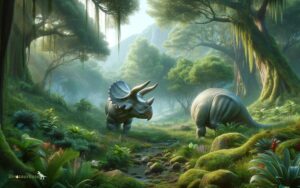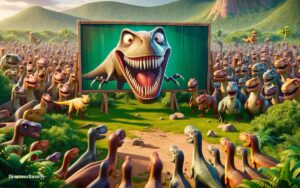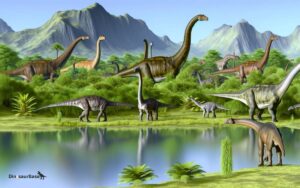How to Make a Dinosaur Model
Embarking on the journey of creating a dinosaur model is akin to being a time traveler, piecing together the fragments of a long-lost era. One starts by choosing their prehistoric titan, a decision that sets the stage for an adventure in craftsmanship and creativity.
They'll need to gather materials that breathe life into their chosen behemoth, crafting bones from wire and flesh from clay.
As they design the skeleton and sculpt the body, adding texture and detailing for realism become critical steps that transform a simple model into a masterpiece. This process not only demands patience but also invites enthusiasts to explore the nuances of prehistoric life. However, the true artistry lies in the finishing touches and the presentation, areas where many hidden techniques await discovery.
Key Takeaways
- Research is crucial for creating an accurate dinosaur model, including its era, environment, and physical characteristics.
- Use high-quality materials and detailed sculpting techniques to replicate the dinosaur's skeleton, skin texture, and features.
- Employ painting techniques like dry brushing and washing to add depth and realism to the dinosaur's appearance.
- Assemble the model with attention to anatomical accuracy and create a realistic habitat scene to enhance the display.
Choosing Your Dinosaur
Selecting the right dinosaur species for your model is crucial, as it sets the foundation for an accurate and educational representation. It's essential to consider factors like the dinosaur's size, habitat, and era when making your choice.
For instance, a Tyrannosaurus rex, a late Cretaceous period carnivore, would require different considerations than a Triceratops, a herbivore from the same period. Additionally, understanding the dinosaur's behavior and environment can guide the model's context, ensuring it reflects paleontological findings.
Opting for a species with well-documented fossil records can also enhance the model's accuracy. By choosing meticulously, creators ensure their model not only captures the imagination but also educates its audience about these prehistoric creatures with scientific precision.
Gathering Materials
Once you've chosen your dinosaur, it's essential to compile a list of materials needed to construct your model with scientific accuracy and detail. This list typically includes modeling clay or plasticine for the main body, which allows for detailed texturing that mimics skin or scales.
Wire or small wooden sticks are necessary for creating the framework, providing stability to the model and ensuring it can support itself. Paints and brushes are also crucial for adding lifelike colors that reflect the dinosaur's hypothesized appearance based on current scientific understanding.
Additionally, tools like sculpting knives and tweezers will aid in shaping and detailing. It's important to gather high-quality materials to ensure the durability and realism of your model, turning it into an educational masterpiece that accurately reflects prehistoric life.
Designing the Skeleton
Before constructing the outer layers of your dinosaur model, it's critical to design its skeleton, ensuring structural integrity and anatomical accuracy. This framework not only serves as the backbone of your creation but also guides the proportions and posture of the final sculpture. To achieve this:
- Study Skeletal Diagrams: Examine detailed diagrams of dinosaur skeletons to understand bone structure and arrangement.
- Scale Appropriately: Calculate the model's scale, adjusting the size of skeletal elements to match.
- Material Selection: Choose materials that can mimic the strength and flexibility of bones, such as wire or lightweight plastic.
- Joint Construction: Design joints to allow for accurate positioning and potential mobility.
- Spinal Alignment: Ensure the spine's curvature aligns with the dinosaur's known posture to maintain realism.
This foundation is vital for a scientifically accurate and visually compelling model.
Sculpting the Body
Once the skeleton design is complete, the next step in creating a dinosaur model involves sculpting the body. Choosing the right materials becomes crucial. Different materials offer varying levels of detail, durability, and workability, affecting the final appearance and longevity of the model.
An overview of shaping techniques provides insight into how to accurately mold these materials into the desired forms, capturing the unique textures and features of dinosaur skin and musculature.
Choosing Your Materials
Selecting the appropriate materials is a critical first step in sculpting the body of your dinosaur model, as it directly influences both the process and the final outcome. The choice of materials depends on the desired texture, durability, and ease of manipulation.
Here's a list of common materials:
- Polymer clay: Versatile and hardens when baked, ideal for fine details.
- Air-dry clay: Easy to use, doesn't require baking, but less durable.
- Epoxy putty: Hardens to a very durable finish, good for structural components.
- Foam: Lightweight and easy to shape, suitable for larger models.
- Wire: Used as an armature to provide stability and support.
Each material serves a unique purpose, enabling creators to bring their vision to life with precision and creativity.
Shaping Techniques Overview
After choosing the appropriate materials for your dinosaur model, it's crucial to understand various shaping techniques to sculpt the body accurately and effectively. One begins by molding the basic shape, paying close attention to the dinosaur's proportions, which vary significantly across species.
Techniques such as carving away excess material help in refining features and adding details like muscles and skin texture. Tools like scalpel blades, wire brushes, and dental tools are invaluable for these finer adjustments.
For larger models, an armature may be used as a skeleton to support the structure, ensuring it remains stable during and after sculpting. Layering is another technique, especially with materials like clay or foam, to build up areas that require more volume, capturing the lifelike essence of the dinosaur.
Adding Texture
To add texture to your dinosaur model, begin by applying a base coat of paint to highlight the creature's intricate skin patterns and scales. The next step involves more detailed work to mimic the lifelike appearance of dinosaur skin.
- Use a fine brush to delicately add darker shades within the scales for depth.
- Apply a diluted wash to create shadow effects in the crevices.
- Dab a sponge lightly in paint and press onto the model for a stippled, skin-like texture.
- Sculpt tiny scales or bumps with modeling clay for areas requiring a 3D effect.
- Gently use a toothbrush to flick specks of paint onto the model for a randomized, natural look.
These techniques ensure the model's texture closely resembles the complex skin of a dinosaur, making it more realistic and visually captivating.
Painting Techniques
Following the texturing phase, the next step in crafting a realistic dinosaur model is the application of paint, which breathes life into the sculpture. Selecting the right types of paints ensures the colors remain vibrant and true to what's known about dinosaur pigmentation, while application methods, including airbrushing and hand painting, contribute to the overall realism by creating gradients and subtle color variations.
Detailing and texturing techniques, such as dry brushing and washes, add depth and realism by highlighting scales, feathers, and other surface textures, making the model appear more lifelike.
Choosing Your Paints
Selecting the right paints is crucial for accurately depicting the colors and textures of your dinosaur model, ensuring that the final product looks as realistic as possible. When choosing paints, consider:
- Acrylics: They're versatile, dry quickly, and are easy to clean up.
- Enamels: Offer a durable finish but require solvents for cleanup.
- Oil-based paints: Provide a longer working time, ideal for blending colors.
- Watercolors: Can be used for subtle shading and tinting.
- Spray paints: Useful for applying base coats or large areas of color.
Each type of paint has its advantages, depending on the effect you're aiming for. Acrylics are generally the go-to for most modelers due to their ease of use and wide range of colors.
Application Methods
Once you've chosen your paints, mastering various application methods enhances the realism and detail of your dinosaur model. The base coat is crucial; it sets the primary color. It's best applied with broad, even strokes to ensure full coverage without pooling.
For shading, a technique called dry brushing highlights the model's texture, giving it a more lifelike appearance. This involves lightly applying a lighter color over the base coat, focusing on raised areas to mimic natural light reflection.
Another method, washing, uses a diluted paint mixture to flow into the recesses, defining the model's intricate details and adding depth. Both techniques require a delicate touch and patience, as building up layers gradually achieves the most natural effect, bridging the gap between a simple model and a dynamic representation of prehistoric life.
Detailing and Texturing
After mastering basic application methods, it's crucial to focus on detailing and texturing techniques to bring your dinosaur model to life with unparalleled realism. These methods mimic the intricate patterns and textures found in nature, enhancing the model's authenticity.
- Dry Brushing: Utilizes a dry, stiff brush to apply light paint on raised surfaces, highlighting details.
- Washing: Involves applying a thin, watery paint to settle into crevices, emphasizing shadows and textures.
- Sponging: Adds variation and a natural texture by dabbing paint with a sponge.
- Layering: Builds up color depth and transitions by applying multiple thin layers of paint.
- Feathering: Blends edges between colors softly, creating a gradual transition ideal for skin tones and patterns.
These techniques require patience and practice but reward with a lifelike representation of prehistoric creatures.
Crafting the Eyes
Crafting the eyes of your dinosaur model involves meticulous attention to detail, ensuring they accurately reflect the creature's era and biology. Start by researching the dinosaur's era to understand the environment it lived in, as this impacts eye color and shape. Predators often have forward-facing eyes for better depth perception, while herbivores may have eyes on the sides of their heads to survey a wider area for threats.
Use high-quality, color-accurate paints to replicate the eye color, adding minute details like the pupil shape and iris patterns. It's crucial to apply a glossy finish to the eyes to mimic the wet, reflective surface of a real eye, adding life and realism to your model. This step requires patience and precision to ensure the eyes are symmetrical and lifelike.
Assembling the Parts
With all the individual parts meticulously crafted, it's time to begin the precise process of assembling your dinosaur model. The assembly requires patience and attention to detail, ensuring each piece fits perfectly with the next. Here's a guide to follow:
- Start with the Skeleton: Assemble the backbone, ribs, and limb bones, ensuring they're correctly oriented.
- Add Musculature: Attach muscle pieces to the skeleton for a more realistic shape.
- Skin Application: Carefully lay the skin over the musculature, smoothing out any wrinkles or bubbles.
- Detailing: Attach the meticulously crafted eyes, teeth, and claws, enhancing the model's realism.
- Final Checks: Review the model for any inaccuracies or loose parts, ensuring everything is secure and accurate.
Adhering to these steps results in a scientifically accurate and visually stunning dinosaur model.
Creating the Landscape
Having assembled the dinosaur model, it's crucial to create a landscape that reflects its natural habitat for a complete and accurate depiction. To do this, one must first research the dinosaur's era—Jurassic, Cretaceous, or Triassic—since each period had distinct environments.
For a Jurassic scene, dense ferns and conifers would dominate, mimicking the lush, green landscapes. For Cretaceous settings, flowering plants, which first appeared during this time, should be included alongside vast grasslands. A Triassic landscape, being the earliest period, would be more barren, with scattered vegetation and large desert areas.
Incorporating realistic water sources, like rivers or lakes, adds another layer of authenticity. Using materials like clay, foam, or even real plants can bring the scene to life, ensuring the model's environment is as scientifically accurate as possible.
Positioning the Model
Once the landscape accurately reflects the dinosaur's era, the next critical step involves strategically positioning the model to mimic natural behaviors observed in fossil records. The placement shouldn't only be visually appealing but also scientifically plausible, offering viewers a glimpse into prehistoric life. Here are key considerations for positioning:
- Ensure the dinosaur's stance is anatomically correct, based on skeletal reconstructions.
- Position predators and prey appropriately, reflecting possible interactions.
- Consider the terrain; herbivores might be near plant life, while carnivores could be placed in stalking poses.
- Adjust the model to suggest movement, giving the scene dynamism.
- Factor in the social behavior of the species, grouping social animals or isolating solitary ones.
This approach aids in creating a more authentic and engaging representation of the dinosaur's natural environment and behavior.
Detailing for Realism
Adding fine details to the dinosaur model transforms it from a simple representation to a lifelike depiction, capturing the essence of its prehistoric existence. To achieve this, one must focus on texture and color.
Scientific research suggests dinosaurs had varied skin textures, from scales to feathers. Implementing such textures, using tools like sculpting knives for fine lines or adding synthetic feathers, enhances realism. Painting requires careful selection of colors, reflecting the latest paleontological findings. For example, studies indicate some dinosaurs displayed vibrant colors for mating or camouflage. Thus, choosing shades that align with these discoveries is crucial.
Additionally, applying techniques like dry brushing to highlight textures can mimic natural wear, adding depth and authenticity. This meticulous attention to detail brings the model to life, making it a true representation of the dinosaur's appearance in its natural habitat.
Displaying Your Model
Once your dinosaur model is complete, the next step is to showcase it effectively.
The choice of location is crucial, as it can either highlight or overshadow the intricate details of your model. Proper lighting is essential to accentuate its features, while a protective display case ensures its preservation.
Choosing the Right Spot
Selecting the ideal location for displaying your dinosaur model is crucial for both aesthetic appeal and preserving the integrity of the piece. Considerations must include environmental factors and the physical space that can impact the model over time. To assist in this decision-making process, here are key points to consider:
- Stability: Ensure the surface is level and sturdy to prevent falls.
- Humidity Control: Low humidity areas are preferable to prevent material degradation.
- Temperature: Avoid places with drastic temperature changes.
- Accessibility: Place it where it's easily viewable but safe from accidental contact.
- Space: Ensure ample room around the model to appreciate its dimensions and details without obstruction.
These factors contribute to the longevity and display quality of your dinosaur model, enhancing your educational and aesthetic enjoyment.
Lighting Enhances Features
Proper lighting plays a crucial role in enhancing the intricate details and realistic appearance of your dinosaur model, bringing its features to life. Strategic placement of lights can accentuate textures, highlight colors, and create shadows that provide depth and dimension.
It's crucial to experiment with different angles and intensities. Direct, focused light can reveal the meticulous craftsmanship of scales and skin patterns, while softer, diffused lighting can simulate natural environments, adding a layer of authenticity.
LED lights are often recommended for their versatility and energy efficiency. They allow for precise control over brightness and color, enabling enthusiasts to mimic various natural lighting conditions, from the harsh midday sun to the softer tones of dawn and dusk, further immersing the model in its prehistoric context.
Protecting Your Creation
After dedicating time and effort to crafting a dinosaur model, it's crucial to consider how best to protect and display your creation to preserve its details and longevity. Here are some strategies:
- Choose a Display Case: Protects from dust, physical damage, and potentially harmful UV light.
- Control Humidity and Temperature: Prevents material degradation, particularly for organic components.
- Avoid Direct Sunlight: Minimizes fading and UV damage.
- Use LED Lighting: Offers illumination without the heat and UV risks associated with other lighting.
- Regular Maintenance: Dust and clean the model carefully to maintain its appearance.
These steps ensure your model remains in pristine condition, allowing it to be admired and studied, reflecting both the majesty of the creatures it represents and the skill involved in its creation.
Maintenance Tips
To ensure your dinosaur model retains its pristine condition, regular cleaning and inspection are crucial. Dust accumulation can obscure details and degrade materials over time. Use a soft brush or compressed air to gently remove dust from delicate parts. For more thorough cleaning, a damp cloth with mild soap can tackle grime without harming the paint or finish. It's vital to avoid harsh chemicals that could strip colors or weaken the structure.
Inspection plays a key role in maintenance. Look for signs of wear or damage, particularly in areas supporting weight or in movable joints. Early detection of issues allows for timely repairs, preventing further deterioration. By adhering to these practices, your model can remain a vibrant representation of prehistoric life for years to come.
Expanding Your Collection
Having ensured your current dinosaur model is in top condition, you may now consider broadening your collection to include diverse species and eras, enriching your understanding of prehistoric life. Expanding your collection involves thoughtful selection and a deep dive into the fascinating variety of dinosaurs that once roamed the earth. Here are some ideas to guide your expansion:
- Include a mix of herbivores and carnivores to reflect the ecological diversity.
- Select species from different periods (Triassic, Jurassic, Cretaceous) for a comprehensive timeline.
- Incorporate both well-known dinosaurs and lesser-known species to broaden your scope.
- Add flying reptiles and marine dinosaurs to explore beyond the land dwellers.
- Consider models that show different stages of life, from hatchlings to full-grown adults, to illustrate growth and development.
This approach not only diversifies your collection but also enhances your appreciation for the complexity of prehistoric ecosystems.
Conclusion
In crafting a dinosaur model, one steps back in time, piecing together history's giants with their own hands. From selecting a prehistoric protagonist to the final display, each stage is a meticulous journey through epochs long vanished.
The modeler's dedication breathes life into ancient bones, offering a tangible glimpse into Earth's primordial past. As they expand their collection, these miniature titans not only adorn shelves but also enrich minds, marrying the art of model-making with the science of paleontology.




